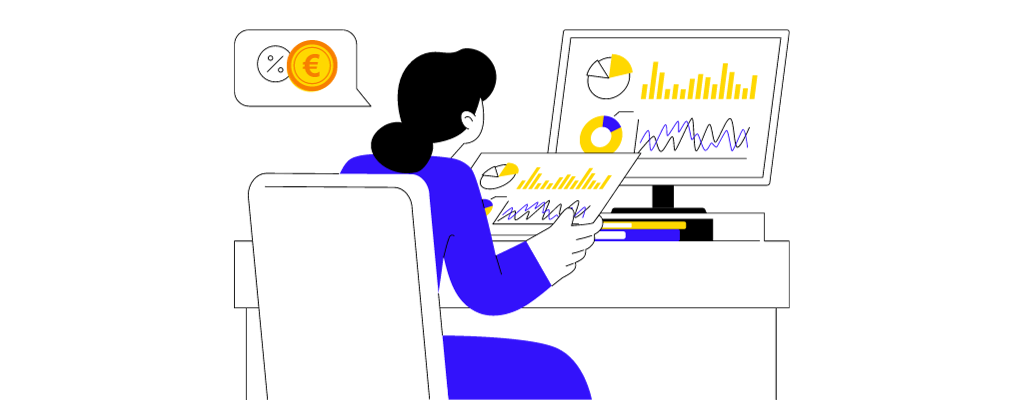
Have you ever come across anything strange in your company’s financial records? While your tax return shows a solid profit, your bank account doesn’t quite correspond. You have money in the paper, but you don’t have any in your pocket.
Learning the ins & outs of cash flow is the key for many business owners who face the same challenge. Despite their frequent interconnection, there is a common misunderstanding between cash flow & profit.
Pay close attention to these terms since they all pertain to crucial aspects of your company. Is the distinction between cash flow and profit something you are unclear about? We will review every detail to help you better comprehend and use these crucial KPIs.
Table of Contents
ToggleHow Does Cash Flow Work?
Cash flow describes a company's monetary inflow and outflow during a specific time. When there is a positive cash flow, more funds are coming in than going out. When there is a negative cash flow, the opposite is true.
Here is a simple cash flow example:
You spent €1 on a chocolate bar today but didn’t make enough to cover your costs. You had a negative cash flow for the day as one euro left your firm while no money came in. You decide to sell the chocolate bar for €2 a few days later. Your company had a positive cash flow for the week as 2 euros came in from the sale of the chocolate bar while €1 went out.
One key difference between revenue and costs is that cash flow describes your company's monetary inflow and outflow. Even if you close a deal today, it can be another 30 days before you have your hands on the cash.
Until then, the money isn’t pouring into your organisation. The same holds for expenses: you can buy a service or product without paying for it immediately. The money leaves your company account when it leaves your pocket.
A Statement of Cash Flow
In the cash flow statement, you detail your cash inflows and outflows. This financial document describes the inflow and outflow of funds for your business over a specific time frame. Here, the time component is crucial. The movement of funds, such as a month, quarter, or year, is measured by cash flow, not at any moment.
Contrast this with balance sheets and other similar financial records. Except when comparing different balance sheets, a balance sheet only shows a business's assets, liabilities, and equity as of a given date; it does not track money flow over time. It gives you a quick overview.
What is Profit?
When you deduct all your expenses from your sales revenue, your profit or net income is the remaining amount. You have a loss if your expenses exceed your income; if the reverse is true, you will profit.
Here are the standard methods for reporting profit include:
Total Earnings
The remaining amount is profit after deducting the expenditures directly related to offering the goods or services. To calculate gross profit, one might deduct the cost of inventory, sales commission, and delivery costs from total revenue.
Overall Profit
What remains after subtracting all other expenses is the profit. Rent, salaries, taxes, and similar expenses would be removed.
Profitability is the ultimate goal of any company, but getting there isn’t always easy. Growth and opportunity might be stifled in the pursuit of profitability. It is often necessary to endure months or even years of losses to lay the groundwork for long-term prosperity.
Profit and Loss Statement
An income statement is a financial statement companies use to disclose their financial performance. Gains or losses can be better understood with the help of these financial records that detail the income and expenditure of your business. Similar to a cash flow statement, it is calculated over time.
How is Cash Flow Different from Profit?
Profit indicates how much money remains after all expenditures have been paid, whereas cash flow shows how much money comes into and goes out of your firm. The income and cash flow statements detail cash inflows and outflows.
Even if a company makes money, it has no cash on hand. A company can have positive cash flow even if it makes no money.
Before Profit, What Matters More: Cash Flow?
There is no right or wrong way to look at cash flow or profit; they show various aspects of your company. Finding a single, universally applicable indicator of a startup’s success is unusual. If you want to know how a company is doing and what it can do in the future, you usually need some financial records.
Investors can care more about your cash flow than your present profitability, for instance, if a recession is on the horizon. Although you can be profitable at the moment, they are more concerned about your ability to continue making money even if you face challenges in the future.
You should monitor both measures to know how your business is doing financially. You can stay prepared by regularly monitoring and improving these KPIs.

Top Ways to Manage Your Cash Flow More Efficiently
Assessments of Financial Well-Being Regularly
Establish a routine to review your cash flow statements regularly to see where you are and what you can do to improve it. It is similar to scheduling regular financial checkups for your company.
Making Sense of Financial Reports
When it comes to the money aspect of running a company, having an accountant on your side can be a huge help. But it helps company owners know the basics of financial accounts. With this information, you can identify problems before they escalate and help plot the future of your company’s financial health.
Planning and Prediction
Ensure your company has a reliable budget and financial plan. You can better prepare for future income and expenditures in this way, leading to a more consistent cash flow. You can compare it to drawing a map of your company’s financial trajectory. To monitor your financial success, it is essential to regularly analyse and compare your actual results with your budget and projections.
Overseeing Receivables
Get your customers to pay you when you say you would. Avoid problems in the cash flow by implementing effective invoicing and collection methods. Offering online payment alternatives, requiring advance deposits, and rigorously following up on delinquent bills are all great ways to facilitate fast payments. Each tactic is critical for a steady flow of funds.
Fund for Emergencies
A corporate emergency fund is similar to a personal one in that it can save your life in an emergency. Leave some of your earnings if you want to be prepared for tough times or unforeseen costs.
Manage Your Cash Flow Efficiently with Outbooks
While profit serves as a measure of success for your firm, cash flow is the lifeblood that ensures its seamless operation. One of the most important things you can do for your financial situation is to learn the difference between profit and cash flow.
To keep your company in Ireland on track for success, Outbooks assist you with tailored solutions. This can help you make sense of your finances when you notice a profit on your tax return but can’t place that money’s source in your firm.
Outbooks offers the right strategies to guarantee that your profit isn’t only theoretical; it will be safely deposited into your bank account.
Seems interesting? Contact Outbooks at info@outbooks.com or +44 330 057 8597 to learn more about our reliable cash flow management solutions today!

